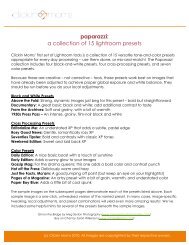Here - Clickin Moms
Here - Clickin Moms
Here - Clickin Moms
You also want an ePaper? Increase the reach of your titles
YUMPU automatically turns print PDFs into web optimized ePapers that Google loves.
The<br />
First<br />
A-ha!<br />
Rock Your Camera 101:<br />
Photography Basics<br />
Rock Your Camera 101 Instructor<br />
So you were a really good girl last year and Santa<br />
left you a brand spankin’ new DSLR under your<br />
tree! Yay!! You need to put that bad boy to use.<br />
Sure you can use like your point and shoot, but<br />
don’t you want to be better than that Don’t<br />
you really want to get kick butt pictures all the<br />
time<br />
The first step is making friends with your meter.<br />
“My what I don’t think mine came with one...”<br />
Move it off the green box! Be crazy! Try P, or Tv/<br />
Shutter Speed priority, or Av/Aperture Priority!<br />
This is your meter, you have it in at least 2 places<br />
on your camera.<br />
On your LCD:<br />
What is it telling you<br />
and through the<br />
viewfinder<br />
Your in camera meter is reading tones, from<br />
white to black. I’m going to assume you’re<br />
shooting in evaluative/matrix/pattern metering.<br />
That is the default metering mode of DSLRs.<br />
Your camera evaluates the whole scene, does<br />
some fancy math on the fly and spits out a meter<br />
reading.<br />
39<br />
A negative reading means that your camera is<br />
seeing everything dark and that it’s darker than<br />
the middle gray that it sees at 0. Middle gray<br />
Think elephant gray. Some cameras see wet elephant<br />
gray at 0, others see dry elephants and<br />
others see in between. That is why some cameras<br />
expose differently.<br />
If you are taking a picture of a black car, then<br />
you want your meter reading to be on the negative<br />
side. If you’re taking a picture of those elephants,<br />
then you’d want your meter at zero.<br />
An image of your blonde haired, blue eyed 5<br />
year old will need to be on the positive side.<br />
Making it work for you<br />
If you are shooting in the automatic modes, you<br />
won’t even see your meter. In the semi-automatic<br />
modes, like P, aperture priority or shutter<br />
speed priority, you can adjust your meter using<br />
exposure compensation. And if you’re feeling<br />
exceptionally wild, move that dial to M and let<br />
the fun begin! You adjust the meter by adjusting<br />
your ISO, shutter speed and/or aperture. Figuring<br />
out that equation of goodness is more than<br />
I can explain here.<br />
More Information on shooting in<br />
manual:<br />
Rock Your Camera 101: The Basics<br />
Tutorials on CM<br />
Understanding Exposure by Brian Peterson






